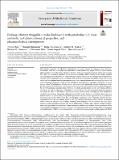Por favor, use este identificador para citar o enlazar a este item:
http://hdl.handle.net/10261/341027COMPARTIR / EXPORTAR:
 SHARE SHARE
 CORE
BASE CORE
BASE
|
|
| Visualizar otros formatos: MARC | Dublin Core | RDF | ORE | MODS | METS | DIDL | DATACITE | |

| Título: | Probing a distinct druggable tubulin binding site with gatorbulins 1–7, their metabolic and physicochemical properties, and pharmacological consequences |
Autor: | Chen, Qi-Yin; Ratnayake, R.; Hortigüela, Rafael CSIC ORCID; Seabra, Gustavo M.; Cameron, Michael D.; Díaz, José Fernando CSIC ORCID ; Oliva, María A. CSIC ORCID ; Luesch, H. | Palabras clave: | Tubulin binding Anticancer drugs Tubulin polymerization inhibitors Total synthesis Gatorbulins |
Fecha de publicación: | 21-oct-2023 | Editor: | Elsevier | Citación: | Bioorganic and Medicinal Chemistry 95: 117506 (2023) | Resumen: | Microtubules, consisting of α/β-tubulin heterodimers, are prime targets for anticancer drug discovery. Gatorbulin-1 (GB1, 1a) is a recently described marine natural product that targets tubulin at a new, seventh pharmacological site at the tubulin intradimer interface. Using our previously developed robust route towards GB1 (1a), we synthesized simplified, first-generation gatorbulins, GB2–7 (1b–1g) of this highly modified cyclodepsipeptide (GB1) that does not contain any proteinogenic amino acid. We systematically investigated the structure-activity relationship at the biochemical and cellular level using GB1-susceptible ovarian and cervical cancer cells. We validated that the hydroxamate moiety in the N-methyl-alanine residue is critical for activity. All other structural modifications present in GB1, including C-hydroxylation of asparagine, methylation at C-4 of proline, and sp2 hybridization in dehydro-alanine, were proven to be functionally relevant. Replacement of the primary amide with a methyl ester also resulted in reduced activity, indicating the intricate scaffold optimization by the GB1-producing cyanobacterium. Inhibition of tubulin polymerization in vitro and binding affinities correlated very well, translating into differentials in cellular efficacy. We used docking and molecular dynamics to evaluate the effects of the chemical simplification at the structural level, indicating that each modification resulted in loss of target interactions, although energetically modest. Similar to cevipabulin that targets two different sites on the tubulin dimer, GB1 promotes proteasome-mediated tubulin degradation but by an unknown mechanism, presumably distinct from that of cevipabulin. Comparison with cevipabulin indicated that this compound binds to the same tubulin region as GB1 (1a), although the binding mode is distinct. Cevipabulin almost exclusively interacts with α-tubulin, including nonexchangeable GTP. In contrast, GB1 (1a) makes extensive contact and hydrogen bonds with both α- and β-chains of tubulin. GB1-7 showed excellent solubility and much higher than that of paclitaxel. Hepatic microsome stability was excellent, human cytochrome P450s were not inhibited and plasma binding was minimal with high free fractions. Passive permeability was predicted to be high based on PAMPA. Parent compound GB1 (1a) was further evaluated using a cellular model with MDCK. | Descripción: | 13 p.-8 fig.-7 tab. | Versión del editor: | https://doi.org/10.1016/j.bmc.2023.117506 | URI: | http://hdl.handle.net/10261/341027 | DOI: | 10.1016/j.bmc.2023.117506 | ISSN: | 0968-0896 |
| Aparece en las colecciones: | (CIB) Artículos |
Ficheros en este ítem:
| Fichero | Descripción | Tamaño | Formato | |
|---|---|---|---|---|
| Bioorganic & Medicinal Chemistry_Chen_2023.pdf | Artículo principal | 7,85 MB | Adobe PDF |  Visualizar/Abrir |
CORE Recommender
SCOPUSTM
Citations
1
checked on 29-abr-2024
Page view(s)
16
checked on 07-may-2024
Download(s)
18
checked on 07-may-2024
Google ScholarTM
Check
Altmetric
Altmetric
Este item está licenciado bajo una Licencia Creative Commons

